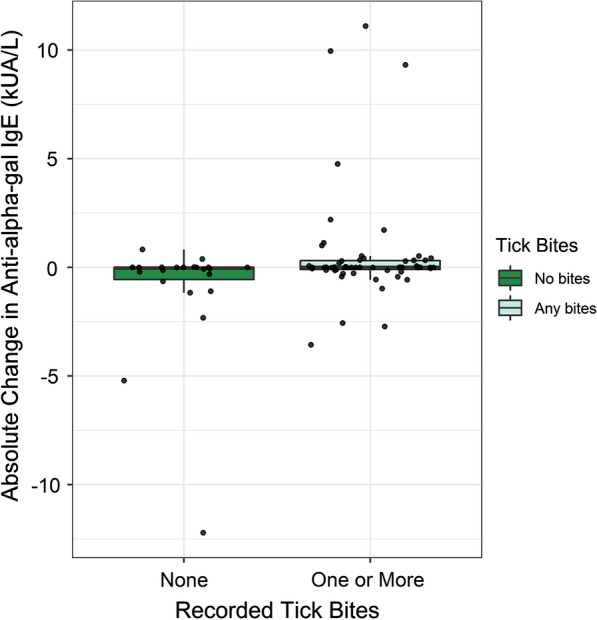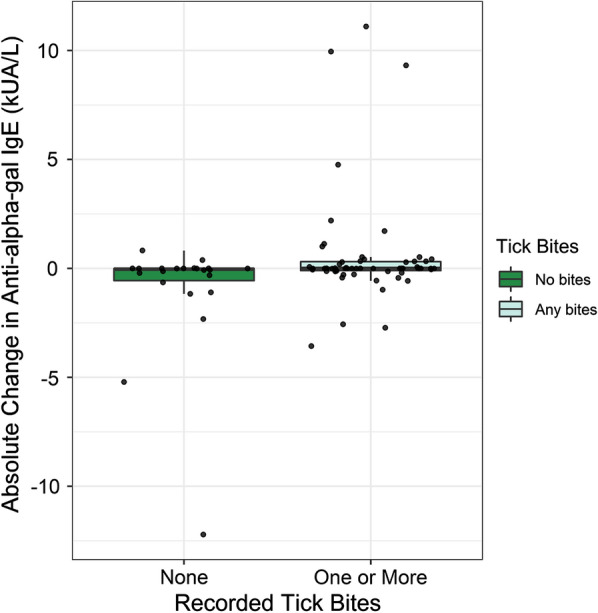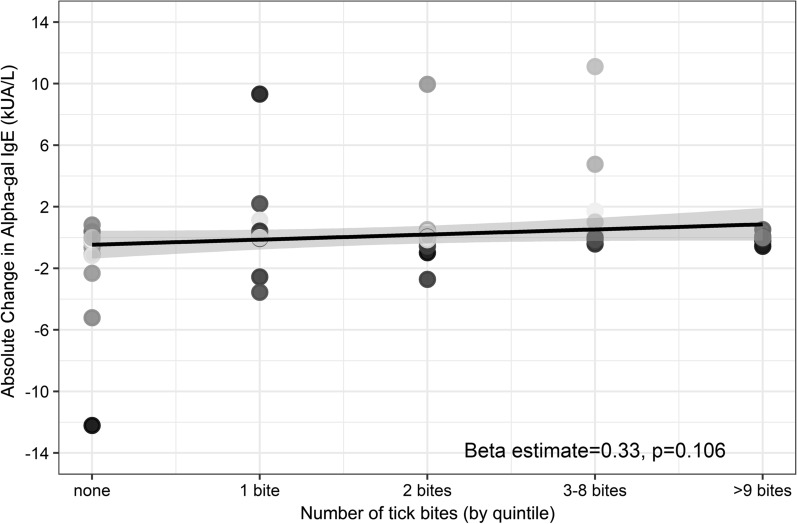Abstract
Background
Alpha-gal is an oligosaccharide implicated in delayed anaphylaxis following red meat consumption. Exposure to tick bites has been correlated with development of an allergic response to alpha-gal. However, evidence prospectively linking exposure to a single tick species and an immune response to alpha-gal is lacking.
Methods
We used serum samples from a prior study cohort of outdoor workers in North Carolina, USA, with high exposure to the lone star tick, Amblyomma americanum, to prospectively evaluate the relationship between tick bites and anti-alpha-gal IgE antibodies.
Results
Individuals who reported exposure to one or more tick bites were significantly more likely to have a positive change in anti-alpha-gal IgE compared to individuals with no reported tick bites. This relationship was not dependent on time. A trend toward increasing number of tick bites and increased anti-alpha-gal IgE levels was observed but not statistically significant.
Conclusion
To our knowledge, this is the first study to prospectively link documented exposure to A. americanum bites and increased sensitization to alpha-gal in a cohort of outdoor workers. Our results support the role of A. americanum as likely agents for eliciting an allergic response to red meat, and highlight the importance of preventing tick bites.
Keywords: Alpha-gal, Amblyomma americanum, Red meat allergy
Background
Alpha-gal syndrome (AGS) is an immunoglobulin E (IgE)-mediated allergy to the oligosaccharide galactose-alpha-1,3-galactose (alpha-gal), present in non-primate mammals [1]. AGS is characterized by a delayed onset allergic reaction following ingestion of mammalian meat (e.g. beef, pork, lamb) or its derivatives, and a positive serum IgE result to alpha-gal (≥ 0.1 kU/l) [1, 2] Since 2009, AGS has been widely reported in North America, Australia, Europe and Asia, with bites from various tick species often suggested as a proximate cause of AGS [3–6]. While these previous reports have proposed a relationship between tick bites and AGS, the nature of the study designs (case reports [1, 3], cross-sectional studies [4, 5] or retrospective epidemiological studies [6]) preclude recording of the exposure prior to the outcome and are vulnerable to recall bias and exposure misclassification. Thus, evidence from prospective studies is needed to confirm the role of tick bites in the development of AGS.
In the USA, most cases of AGS have been reported from the Southeast, where the lone star tick, Amblyomma americanum, is a prevalent and problematic human-biting species [7, 8]. Lone star tick bites have been retrospectively or circumstantially linked to the development of AGS [1, 3]; however, to date no study has evaluated changes in immune sensitization to alpha-gal following documented exposure to A. americanum bites. The purpose of this study was to prospectively define the relationship between A. americanum tick bites and anti-alpha-gal IgE antibody levels in a cohort of outdoor workers in the state of North Carolina, USA.
Methods
Study design and participants
This study analyzed serum samples from a previous randomized control trial (RCT) of North Carolina outdoor workers [9]. Briefly, the RCT enrolled North Carolina state park and forestry employees who worked outdoors ≥ 10 hours/week during peak tick season, were over age 18, were not pregnant or planning to become pregnant during the study, had no known sensitivities to insecticides, and provided written informed consent. The study spanned two tick exposure seasons defined as March to October of 2011 and 2012 and was conducted to evaluate the protective effect of permethrin treated clothing for the prevention of tick bites [9]. Serum samples were collected before and after each tick exposure season during the initial RCT to test for the presence of tick-borne pathogens. Samples were only included in this study for participants who provided written informed consent for specimen storage and use for consecutive studies during the RCT. Inclusion of samples was further restricted to participants with paired sera that spanned at least one tick exposure season and were collected ≤ 12 months apart. The use of paired sera allowed for the evaluation of the change in alpha-gal at the individual level to control for variation in baseline alpha-gal titers across participants.
Anti-alpha-gal IgE antibody measurement and tick exposure assessment
Levels of anti-alpha-gal IgE were measured for all included samples using a previously validated ImmunoCAP assay [1]. A threshold for anti-alpha-gal IgE response of > 0.1 kUA/l was used to maximize sensitivity to antibody levels which have been detected as low as 0.1kUA/l among patients with clinical symptoms and allergic reactions to alpha-gal [2]. Tick bites were recorded using weekly logs during the parent study and removed ticks were sent by study participants to an entomology laboratory at North Carolina State University for identification. Baseline participant characteristics and weekly tick bite exposure data were extracted from the parent study.
Statistical analysis
The main exposure variable was tick bites, dichotomized as ≥ 1 bites or 0 bites recorded between serum collection times. The outcome was measured as an absolute change in anti-alpha-gal IgE levels between serum collections. A linear mixed-effects model assuming compound symmetry correlation across time was used to evaluate the change in anti-alpha-gal IgE levels in response to tick exposure (any bites versus none) and time as the predictors. The analysis was conducted using all paired sera pooled across study years, and included a random intercept to control for repeated measures. A threshold of 0.05 was used for statistical significance testing.
Results and discussion
Characteristics of the study population
There were 81 paired samples from 52 study participants meeting eligibility requirements. The average age of participants was 40 years (range: 25–58 years), 79% were male; 73% (59/81) of paired samples had ≥ 1 tick bite during the study period. A total of 358 ticks were sent in by 41 participants for identification across the study period. Of these, 97% (347/358) were identified as A. americanum of which, 58% were nymphs or larvae. The other 3% of submitted ticks were identified as Dermacentor variabilis (n = 7), Amblyomma maculatum (n = 3) and Ixodes scapularis (n = 1). All participants who reported one or more tick bites and sent in ticks for identification had documented exposure to 1 or more A. americanum ticks. Of the 11 participants who did not send in ticks, 8 reported no tick bites during the study period.
The prevalence of anti-alpha-gal IgE antibodies > 0.1kUA/l among participants at baseline, regardless of tick exposure, was 58% (30/52), at the end of the first year it was 60% (31/52), and among those who completed two years of the study, it was 69% (20/29). Of the participants with undetected anti-alpha-gal antibodies at baseline, new sensitizations appeared in 4 individuals within their first year of the study. The overall median anti-alpha-gal IgE levels were 0.29, 0.22, and 0.25 kUA/l at baseline, the end of study year 1, and the end of study year 2, respectively.
Association between tick bites and alpha-gal sensitization
Results from our mixed effects analysis revealed that exposure to one or more tick bites was significantly associated with an increase in mean anti-alpha-gal IgE (estimate = 1.99, 95% CI: 0.39–3.60, P = 0.02). Participants who reported any tick bites experienced an average increase in alpha-gal sensitization of 1.99 kUA/l (95% CI: 0.39–3.60 kUA/l) compared to individuals who reported no tick bites, controlling for time and individuals with repeated measures. The relationship between tick bites and change in alpha-gal sensitization did not significantly depend on study year (estimate = 0.25, 95% CI: − 2.10–2.60, P = 0.84). The distribution of changes in anti-alpha-gal levels among participants based on their tick bite exposure status during both study years is shown in Fig. 1.
Fig. 1.

Distribution of absolute change in alpha-gal IgE sensitization across paired samples, grouped by tick bite exposure represented by boxplots. For each group, the box is bound by the upper and lower quartile of data as distributed about the median, vertical lines extend from the box to the maximum and minimum ranges of the data estimated by 1.5*interquartile range. Data points representing the absolute change in alpha-gal IgE for each sample overlay the boxplots. Abbreviations: IgE, immunoglobulin E
Secondary dose response analysis
We also investigated whether differences in anti-alpha-gal IgE levels were associated with the number of tick bites. Tick bite numbers were binned by quintiles of occurrence across the full study. Quintile intervals were zero bites, 1 bite, 2 bites, 3–8 bites, and ≥ 9 bites. A tendency toward increased change in anti-alpha-gal IgE with increased tick exposure was observed (Fig. 2), but it was not statistically significant (estimate = 0.33, 95% CI: − 0.07–0.73, P = 0.106). This observed pattern does not change among participants with a baseline sensitivity to alpha-gal (anti-alpha-gal IgE > 0.1kUA/l), data not shown.
Fig. 2.
Change in alpha-gal IgE sensitization tends to increase with the number of reported tick bites; however, the estimated average increase of 0.33 kUA/L of alpha-gal IgE for each 1-quintile increase in reported tick bites is not significant (estimate: 0.33, CI: − 0.07 to 0.73, P = 0.106). Abbreviations: IgE, immunoglobulin E; CI, confidence interval
Study limitations
The major study limitation is the small sample size and lack of information regarding symptoms commonly associated with AGS. As a result, there were no reported cases of red meat allergy. Although the findings are limited by exposure to one tick species, A. americanum, appears to be the most relevant species in the USA based on geographical range [8]. We also note the high baseline sensitivity of this cohort to anti-alpha-gal antibodies (58% positive at baseline) presumably due to exposure to A. americanum prior to enrollment in the parent study. This may have reduced the effect size observed in this study as opposed to a sample of A. americanum naïve individuals. Acknowledging these limitations, this is the first report to prospectively link A. americanum bites to significantly increased anti-alpha-gal IgE.
Conclusions
Our results show that documented exposure to at least one A. americanum bite is associated with statistically significant positive change in anti-alpha-gal IgE levels. While our study found that any exposure to A. americanum bites is significantly associated with increased sensitization to alpha-gal, we were unable to detect a significant dose response between the number of tick bites and increasing anti-alpha-gal IgE levels, likely due to the small study size. Additional studies are needed to fully characterize the relationship between the frequency of tick bites and changes in alpha-gal sensitization. However, the results presented here indicate that anti-alpha-gal IgE antibody levels increase following documented exposure to the lone star tick and support the importance of preventing tick bites as a measure of protection against increased alpha-gal sensitization.
Acknowledgements
We would like to thank the participants in the parent study (TICS study), without their contributions and selfless consent for specimen storage and use, this study would not have been possible.
Abbreviations
- AGS
alpha-gal syndrome
- IgE
immunoglobulin E
- RCT
randomized control trial
Authors’ contributions
CLM was involved in the analysis and interpretation of the data and drafted the manuscript. FCL was involved in the analysis and interpretation of the data. MV was involved in the acquisition of the data and in the conceptualization and administration of the parent study. CSA was involved in the acquisition of the data and conceptualization and administration of the parent study. SRM made substantial contributions to the conception and design of the work and was involved in the acquisition and interpretation of the data, and helped draft and revise the manuscript. SPC made substantial contributions to the conceptualization and design of the work and helped draft and revise the manuscript. All authors read and approved the final manuscript.
Funding
This work was supported by the Centers for Disease Control and Prevention and the National Institute for Occupational Safety and Health (R01 OH009874 to MV, CSA and SRM, and R01 OH010791 to SRM), and the National Institute of Allergy and Infectious Diseases (R01 AI135049 to SPC).
Availability of data and materials
The datasets used for analysis during this study are available from the corresponding author upon request.
Ethics approval and consent to participate
This is a substudy of a parent study which obtained approval from the institutional review board at the University of North Carolina (IRB no. 10-1027). In the parent study all participants provided written informed consent for participation and were asked for permission to store and use their specimen(s) for future studies. Only those who provided consent for stored specimen(s) were included in this analysis.
Consent for publication
Not applicable.
Competing interests
SPC is on the Genentech speakers bureau; the content of the manuscript has not been influenced by this potential conflict of interest. CLM, FCL, MV, CSA and SRM declare that they have no competing interests.
Footnotes
Publisher's Note
Springer Nature remains neutral with regard to jurisdictional claims in published maps and institutional affiliations.
References
- 1.Commins SP, Satinover SM, Hosen J, Mozena J, Borish L, Lewis BD, et al. Delayed anaphylaxis, angioedema, or urticaria after consumption of red meat in patients with IgE antibodies specific for galactose-alpha-1,3-galactose. J Allergy Clin Immunol. 2009;123:426–433. doi: 10.1016/j.jaci.2008.10.052. [DOI] [PMC free article] [PubMed] [Google Scholar]
- 2.Commins SP. Diagnosis & management of alpha-gal syndrome: lessons from 2,500 patients. Expert Rev Clin Immunol. 2020;1–11. [DOI] [PMC free article] [PubMed]
- 3.Commins SP, James HR, Kelly LA, Pochan SL, Workman LJ, Perzanowski MS, et al. The relevance of tick bites to the production of IgE antibodies to the mammalian oligosaccharide galactose-α-1, 3-galactose. J Allergy Clin Immunol. 2011;127:1286–1293. doi: 10.1016/j.jaci.2011.02.019. [DOI] [PMC free article] [PubMed] [Google Scholar]
- 4.Fischer J, Lupberger E, Hebsaker J, Blumenstock G, Aichinger E, Yazdi AS, et al. Prevalence of type I sensitization to alpha-gal in forest service employees and hunters. Allergy. 2017;72:1540–1547. doi: 10.1111/all.13156. [DOI] [PubMed] [Google Scholar]
- 5.Gonzalez-Quintela A, Dam Laursen AS, Vidal C, Skaaby T, Gude F, Linneberg A. IgE antibodies to alpha-gal in the general adult population: relationship with tick bites, atopy, and cat ownership. Clin Exp Allergy. 2014;44:1061–1068. doi: 10.1111/cea.12326. [DOI] [PubMed] [Google Scholar]
- 6.Hashizume H, Fujiyama T, Umayahara T, Kageyama R, Walls AF, Satoh T. Repeated Amblyomma testudinarium tick bites are associated with increased galactose-α-1,3-galactose carbohydrate IgE antibody levels: a retrospective cohort study in a single institution. J Am Acad Dermatol. 2018;78:1135–1141. doi: 10.1016/j.jaad.2017.12.028. [DOI] [PubMed] [Google Scholar]
- 7.Gleim ER, Conner LM, Zemtsova GE, Levin ML, Wong P, Pfaff MA, et al. Rickettsiales in ticks removed from outdoor workers, Southwest Georgia and Northwest Florida, USA. Emerg Infec Dis. 2018;25:1019–1021. doi: 10.3201/eid2505.180438. [DOI] [PMC free article] [PubMed] [Google Scholar]
- 8.Lee S, Kakumanu M, Ponnusamy L, Vaughn M, Funkhouser S, Thornton H, et al. Prevalence of Rickettsiales in ticks removed from the skin of outdoor workers. Parasit Vectors. 2014;7:607. doi: 10.1186/s13071-014-0607-2. [DOI] [PMC free article] [PubMed] [Google Scholar]
- 9.Vaughn MF, Funkhouser SW, Lin FC, Fine J, Juliano JJ, Apperson CS, et al. Long-lasting permethrin impregnated uniforms: A randomized-controlled trial for tick bite prevention. Am J Prev Med. 2014,;46:473–80. [DOI] [PubMed]
Associated Data
This section collects any data citations, data availability statements, or supplementary materials included in this article.
Data Availability Statement
The datasets used for analysis during this study are available from the corresponding author upon request.



